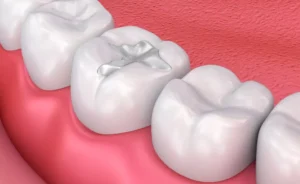Did you know that over 90 percent of adults have had at least one cavity in their lifetime?
Facing dental fillings is an issue that has been around for centuries. Luckily today there are better options than beeswax, which may have been used to fix cracked teeth 6,500 years ago.
And while traditional metal fillings have been the popular choice for a while, composite dental fillings have started to take over a significant share of the fillings industry, and are expected to grow at an annual rate of 7 percent through 2030.
At Hancock and Johnston Dentistry in Lubbock, we have been only performing composite fillings for over 20 years.
What Are Composite Fillings?
Composite fillings are made from a mixture of glass or quartz filler and plastic (acrylic) resin, which creates a tooth-colored material that blends in with natural teeth.
In addition to fillings, dentists use composite material for veneers, inlays, crowns, and to restore parts of broken or chipped teeth.
Getting a composite filling is typically a one-visit procedure. We start by selecting a filling shade to match your teeth. Then we will make the area comfortable by numbing the tooth and surrounding area with local anesthesia before removing the decay. Next, we will etch and bond the tooth and begin layering the composite filling into the tooth.
We continue the process by curing the composite filling to set it, setting each layer as we go along. We then shape the tooth and polish it before checking your bite.

| WHAT TYPES OF CAVITY FILLING PROCEDURES ARE AVAILABLE? |
| Amalgam fillings: Amalgam is a silver mixture of metals, such as copper, tin, zinc and mercury. More appropriate for back molars. Durable option that lasts a long time. |
| Composite fillings: The material is tooth-colored and consists of resin and glass. |
| Glass ionomer fillings: Made of powdered glass that bonds with the teeth (also tooth colored). |
Source: https://www.webmd.com/oral-health/guide/dental-health-fillings
Pros and Cons
The most obvious benefit of composite dental fillings is that they look natural, blending in with your teeth. They are also durable and resistant to fracture from the stress of chewing. Multiple studies have shown that you can get anywhere from 7 to 10 years out of a composite filling.
On the downside, you may feel some temperature sensitivity afterward, which can occur any time a tooth is worked on, but it doesn’t last long. And, even though they’re durable, composites may not have the longevity of amalgam or gold fillings. Most of the longevity is determined in how well the teeth are taken care of by the patient.
PROS
- Aesthetically pleasing: Composite fillings are tooth-colored and blend in with natural teeth, making them a great choice for visible teeth. They also do not contain mercury like amalgam fillings.
- Minimal tooth removal: Composite fillings require less tooth removal compared to amalgam fillings. This makes it a less invasive procedure.
- Versatile: Composite fillings can be used for a variety of dental restorations, including filling cavities, repairing chipped or cracked teeth, reshaping teeth, and closing gaps between teeth.
- Bonding: Composite fillings bond directly to the tooth, which adds strength to the tooth structure.
- Quick procedure: Composite fillings generally require only one appointment, making them a convenient choice for patients.
CONS
- Cost: Composite fillings may be more expensive than some other types of fillings.
- Durability: While composite fillings are durable (5-10 years), they may not be as long-lasting as other types of fillings, such as silver amalgams (10-15 years) or gold (up to 20 years).
- Sensitivity: Some patients may experience sensitivity to hot and cold temperatures after getting a composite filling, as all teeth can be after having work done on them.
- Staining or chipping: Composite fillings can stain over time, especially if the patient smokes or drinks coffee or red wine. It’s also more likely for composite fillings to chip off the tooth, especially if you’re prone to teeth grinding.
- Technique sensitive: The placement of composite fillings requires a skilled and experienced dentist, as it is a technique-sensitive procedure. And, because of the process, composite fillings can take up to 20 minutes longer to place.
 A Final Word
A Final Word
In conclusion, composite fillings are growing to be the most popular choice for dental restoration — and with 175 million fillings performed in the United States per year, that’s saying a lot.
Contact us to weigh the pros and cons of the different filling options. At Hancock and Johnston Dentistry, we always take into account your unique dental situation before making a treatment plan. You can feel confident that you’re making the right choice for your dental needs because our technologically advanced and highly skilled team is here to guide you.

